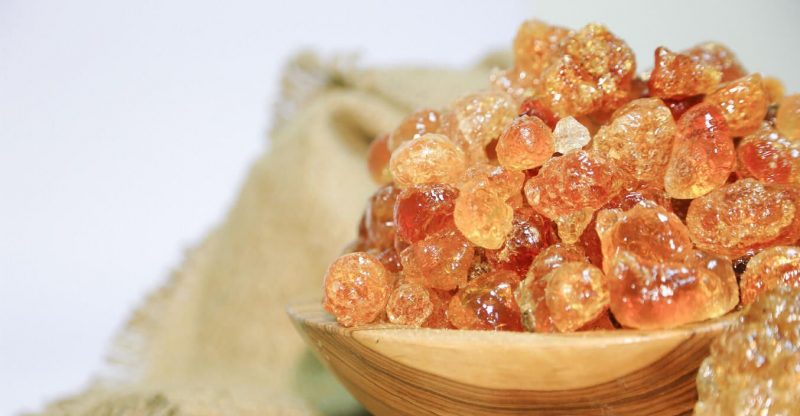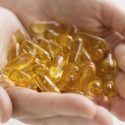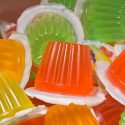What is Gum Arabic (E414) in food: Sources, Uses, Health benefits, Substitutes

What is it | Uses | Safety | Benefits | Side effects | FAQs
Gum arabic or acacia gum, a natural gum usually used as a thickener, emulsifier and binder in food with the European food additive number E414. It is a dried exudation derived from the stems and branches of acacia trees, commonly come from acacia senegal and acacia seyal.
It is reported that Sudan, Chad & Nigeria take the 95% share of the world market of acacia gums in 2010. (1)
What is Gum Arabic?
Definition
By JECFA definition, Gum arabic is a dried exudate obtained from the stems and branches of Acacia senegal (L.) Willdenow or Acacia seyal (fam. Leguminosae). (2)
Composition
It consists mainly of high-molecular-weight polysaccharides and their calcium, magnesium and potassium salts.
It is a complex combination of polysaccharides and glycoproteins. Arabinogalactan (around 90% of gum) and arabinogalactan–protein (around 10% of gum) are two main components of arabic gum.
It mainly contains the following monomeric units when hydrolysis and their percentages as follows:
- D-galactose(32.5–35.0%)
- L-arabinose (31.7–53.1%)
- L-rhamnose (2.7–16.3%),
- D-glucuronic acid (5.3–14.0%)
- 4-O-methyl-glucuronic acid (0.8–5.2%)
- Protein (1.5-3.0%)
Structure
It is a highly branched structure consisting of a b-1,3-linked D-galactose core with extensive branching through 3- and 6-linked galactose and 3-linked arabinose.
Two grades of gum arabic
Arabic gum is mainly divided into two types based on the two tree sources: acacia senegal (hashab grade) and acacia seyal (talha grade).
Both grades have the same compositions and sugar residues but with different content. The average molecular mass of the gum obtained from A. senegal is higher than from that of A. seyal.
Most internationally traded gum arabic comes from acacia senegal.
1. Hashab
Acacia senegal is a bushy tree, having a wide distribution in Africa and Western Africa.
2. Talha
Acacia seyal is a small to medium size tree, up to 10 -12m height. Talha grade is more brittle than Hashab grade.
Four forms of gum arabic
Gum arabic can be classified into 4 forms (raw material, middle, powdered and spray-dried) according to the degree of the manufacturing process.
1. Raw gum arabic
It is the raw form only through manual treatment sorting out the lumps, according to the size, colour, and visual aspect. It is mainly used for food application: confectionery and wine.
2. Kibbled acacia gum
It is the raw acacia gum after grinding process, in order to reduce the size of the gum lumps. The wood / bark particles and any other foreign materials can be removed after kibbling flow. The kibbled form is traditionally used in confectionery production.
3. Powdered acacia gum
It is the fine powder obtained from the finely milling of the kibbled acacia gum, which looks like flour. This powder is dusted on the surface of candies in confectionery production; and in pharmaceuticals application where special powder density is needed for pills. (3)
4. Spray-dried Acacia gum
It is pure form and the main use of the product over the world.
How is it made?
Acacia gum is the result of a bacterial or fungal infection mostly on the wild trees also in cultivated gardens. It is exuded or produced only from unhealthy trees which were stimulated by heat, poor nutrition and drought.
Generally, the following are 6 steps manufacturing process of gum arabic powder.
Tapping
The farmers of West & South East Sudan start tapping the two species of arabic trees, acacia senegal and acacia seyal in Autumn. They make small cuts in the bark to allow the glue-like sap to seep out.
Collection
The hardened gum arabic nodules are gathered under the sun for a few days to make it dry.
Manual cleaning
The dried gum is then cleaned manually to remove small bark fibers and any other impurities.
Dry purification processing
Using kibbling, sieving and pulverization to remove vegetable and mineral impurities.
Aqueous solution purification
This step is much more efficient. Dissolve the gum in water and all the impurities can be removed by a series of filtration steps.
Dry
With roller drying or spray dried processes to concentrate the gum syrup and get rid of bacterial contamination.
Nowadays spray dried method is the common way to produce acacia gum. It can keep all properties of the raw gum while roller drying method reduces its emulsifying properties by drastic thermal treatment.
Spray dried acacia gum has the lower content of water (loss on drying not more than 10%) than the not spray-dried acacia gum (loss on drying not more than 15%).
Specification
|
Other Names |
|
|
CAS Number |
9000-01-5 |
|
Chemical formula |
NA |
|
Molecular Weight |
Approximately 350,000 |
Appearance
Unground acacia gum is a white or yellowish-white spheroidal tears with different sizes. Also available in the form of flakes, granular, powder or spray-dried powder.
Solubility
It is a cold water-soluble polysaccharide and a multi-functional hydrocolloid. 1g dissolves in 2 mL cold water; insoluble in ethanol.
Viscosity
It has a low viscosity, and its viscosity of 30% gum arabic solution is lower than 1% of CMC at low shear rates. (4)
What’s the application of gum arabic?
Acacia Gum is commonly used in food, cosmetics and pharmaceuticals for its thickening, emulsifying and binding properties. Not only is it used for its functional benefits, it’s also valued as a natural ingredient that contributes dietary fiber.
Food
Food grade gum arabic powder is a widely edible gum that can be found in the bakery, confectionery, beverage, dairy and so on. More than 80% of gum arabic is used in the food production for emulsification, encapsulation, coating, gum candies and so on. (5)
Bakery
Generally, in the baking industry, gum arabic is used for its low water absorption, viscoelastic properties and high soluble fiber characteristics.
Bread
It can be used as an emulsion stabilizer, also it imparts smooth, increases dough height, as well as enlarges the volume of bread.
Egg Substitute
It can replace eggs for generating an attractive glossy coating, which will be appropriate for vegetarians and people allergic to eggs.
Frozen dough
It reduces ice crystallization in frozen dough.
Tortilla
It increases tortilla roll-ability, water retention, and shelf life.
Confectionary
Gum arabic can be used as a glaze or coating in confectionery and the common uses are in chocolates, candies and chewing gum. Generally, the purpose is to prevent sugar crystallization, modify texture, keep the emulsion stable and distribute fatty components evenly.
Drinks
Gum arabic can be used in soft drinks due to such advantages:
- the low viscosity: that will not make a change to the overall viscosity of the beverage.
- excellent solubility in aqueous solution.
- stable in a wide PH range.
- as a stabilizer in oil in water emulsions.
- strengthen the foam stability in beer and soft drinks.
- as a fining/clarifying agent in winemaking.
- low calorie.
- as a carrier for flavor encapsulation.
Cosmetics
Per the “European Commission database for information on cosmetic substances and ingredients”, guar gum can function as a film forming and masking agent in cosmetic and personal care products. (6)
We can find the following personal care products contain it:
- Mascara
- facial moisturizer
- anti-aging
- body wash
- liquid hand soap
- hair spray
- lipstick and others
Pharmaceuticals
In the Pharmaceutical industry, acacia gum is used as an excipient, e.g. as a suspending and emulsifying agent, as an adhesive and binder in tableting and demulcent syrups, as EFSA mentioned.
Others
Gum arabic is the traditional binder used in watercolor paint for artists as it can easily dissolve in water and other color pigments are suspended in the acacia gum that results in watercolor paint.
Other uses including ceramics, photography, lithography, inks (calligraphy), printmaking and so on.
Is Gum Arabic Safe to eat?
Yes, it almost has no side effects and the safety has been approved by the U.S. Food and Drug Administration (FDA) and European Food Safety Authority (EFSA), as well as the Joint FAO/WHO Expert Committee on Food Additives (JECFA).
FDA
The FDA claimed gum arabic added directly to human food affirmed as generally recognized as safe (GRAS). The following food may contain it and with the max uses levels (from high to low) (7):
- Soft candy: 85.0%
- Hard candy and cough drops: 46.5%
- Confections and frostings: 12.4%
- Nuts and nut products: 8.3%
- Quiescently frozen confection products: 6.0%
- Chewing gum: 5.6%
- Snack foods: 4.0%
- Gelatins, puddings, and fillings: 2.5%
- Beverages and beverage bases: 2.0%
- Fats and oils: 1.5%
- Dairy product analogs: 1.3%
- All other food categories: 1.0%
The following applications are also approved by the FDA. Gum arabic can also function as a dietary fiber besides the above mentioned properties. (8)
- Breakfast cereals
- Cakes, brownies, pastries, biscuits, muffins, and cookies Grain-based bars (e.g., breakfast bars, granola bars, rice cereal bars)
- Soups and soup mixes
European Food Safety Authority
Acacia Gum (E 414) is authorised as a food additive in the European Union (EU) in accordance with Annex II and Annex III to Regulation (EC) No 1333/2008 on food additives and categorized as “additives other than colours and sweeteners” (9)
Re-evaluation The Safety In 2017
After the study on genotoxicity, carcinogenicity, reproductive and developmental toxicity, EFSA concluded that “there is no need for a numerical ADI for acacia gum (E 414), and there is no safety concern for the general population at the refined exposure assessment of acacia gum (E 414) as a food additive.” (10)
Uses
Its approved applications are listed separately E414 and in Group I where the uses is quantum satis (QS).
Following foods may contain it:
- Cocoa and Chocolate Confectionary
- Table-top sweeteners
- Processed cereal-based foods and baby foods
- Beer and malt beverages
UK Food Standards Agency
Categorized as an emulsifier, stabiliser, thickener and gelling agent. (11)
Food Standards Australia New Zealand
It is an approved ingredient in Australia and New Zealand with code number 414. (12)
JECFA
Function Class: food additives, emulsifier, stabilizer, thickener. (13)
ADI: ADI not specified set since 1989. (14)
What are the health benefits?
Acacia gum is also referred to as acacia fiber. Apart from its functional properties, it is a source of soluble dietary fiber which contains about 85% dissolvable dietary fiber (15) that is beneficial to a healthy diet. It is also a low calorie ingredient with 1.8-2.0 kcal/g.
However, it has not been approved as a fiber source by FDA. The detailed status of gum arabic as dietary fiber is from TIC Gum, the supplier in the US.
By the way, fibers currently on FDA’s list (16) :
- Beta-glucan soluble fiber
- Psyllium husk
- Cellulose
- Guar gum
- Pectin
- Locust bean gum
- Hydroxypropylmethylcellulose
The following are 6 health benefits for our body.
1. Prebiotic functionality
A study in 2008 demonstrated that gum arabic had the prebiotic function at least as good as inulin. (17)
A study in 2015 found acacia gum (at the dose of 10 g/d) can increase the bacteria groups of Bifidobacteria, Lactobacilli and total lactic acid.
2. Improve irritable bowel syndrome (IBS) symptoms
A study published in 2012 found that the combination of acacia fiber and B. lactis in yogurt has greater therapeutic effects in patients with IBS than standard yogurt among 130 patients. (18)
3. Lower cholesterol
Soluble dietary fibers can reduce the total cholesterol and the low-density lipoprotein cholesterol, which leads to coronary heart disease.
4. Low the risk of type II diabetes
A study in 2013 showed that insoluble fiber intake may decrease the risk of type II diabetes while soluble fiber did not have this benefits. (19)
5. Control weight
A study in 2018 found that the consumption of Gum Arabic (acacia senegal) at a dose of 30 g/d for 3 months may play an effective role in preventing weight gain among 91 type 2 diabetic patients.
6. Reduce glucose index
A trial was conducted in Sudan from August 2014 to February 2015, which showed that Gum Arabic (acacia senegal) had a signal significance reduction in fasting plasma glucose among 120 type 2 diabetic patients. (20)
What are the possible side effects?
It is common that sometimes consumers have questions whether acacia gum is bad for our health and what are the side effects. It is generally considered safe but some people may be allergic to it and will cause symptoms like asthma.
Allergy
Occupational sensitisation to acacia gum at work exposure leading to allergic rhinitis, asthma, and urticaria. (21)
It also showed some people had symptoms like nausea, mild diarrhea and bloating abdomen in the study of 120 healthy females which was reported in 2012. (22)
Other side effects
It is generally safe and with few other side effects.
Is it safe to pregnant?
There were no adverse effects on female fertility from the EFSA’s study of the reproductive and developmental toxicity of gum arabic on mice, rats, hamsters and rabbits.
Frequently asked questions
Yes, from the raw material and the manufacturing process mentioned above we can know gum arabic is a natural gum.
Yes, it is generally recognized as halal complying with the policy of Muslim.
Yes, it is kosher pareve. It has met all the “kashruth” requirements and can be certified as kosher.
Yes, it is gluten free according to the definition of FDA of gluten free food as gum arabic does not contain wheat, rye, barley, or crossbreeds of these grains. (23)
Yes, it is vegan. gum arabic is a natural gum that is sourced from the acacia trees and the manufacturing process without the use of animal matter or products derived from animal origin. So it is appropriate for vegetarian diets recipes.
What are the substitutes of Gum Arabic?
Other thickeners, such as xanthan gum, locust bean gum, carrageenan, or guar gum can used as an alternative in some food applications.
Conclusion
Now you may have a good knowledge of the thickener – Gum arabic (E414), from the following aspects:
- Composition: arabinogalactan and arabinogalactan–protein.
- Two grades: hashab grade (derived from acacia senegal) and talha grade (from acacia seyal)
- Four forms in the market: raw gum arabic, kibbled, powdered and spray-dried)
- Production
- Uses: in bakery, confectionery and drinks.
- Approved safety
- Possible side effects
- Health benefits
- FAQs such as is it vegan, gluten free, synthetic or natural.
What kinds of food packaging have you found this ingredient in? Let me know in the comments.


